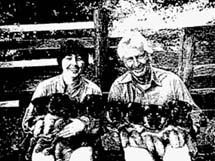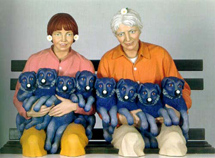Is the work a derivative work? How can you tell?
While a work is protected by copyright, only the owner of the copyright in that work has the right to create, or to authorize someone else to create, a new version of that work. But what about public domain works? Aren’t they free for the taking? Yes ... but even when a work is in the public domain, a new work that’s based on it may be protected by copyright.
How? Let’s see.
A derivative work is a new version of an already existing work
Let’s start with a definition. A “derivative work” is based on (or derived from) one or more already existing works. It’s a new version of the work, basically. Derivative works include things like translations, musical arrangements, dramatizations, fictionalizations, art reproductions, and condensations. (If you want the statutory definition, see 17 USC § 101.)
Maybe some examples would help?
All of these would be copyrightable derivative works (just to give you an idea), as long as they were original works of authorship:
- A screenplay based on a novel (an adaptation)
- A translation into of an English language novel into Russian
- A translation of a work into a new medium, such as a written work into an audio book
- A recording of a song remixed with an already existing song
- A book of maps based on public domain maps, and including some new maps
- A lithograph based on a painting
- A biography of someone that contains their journal entries and letters
- An arrangement of words and music based on a piece by Bach
- A new musical arrangement based on a traditional folk song
- A computer program that revises or modifies the source code of an already existing program, or translates it into another computer language
- A pictorial version (graphic novel; comic book) of a public domain novel
- A fictionalization of a factual work, such as a novel based on a historic account of a battle
- An abridgement (a shortened or condensed version) of a novel
- A drawing based on a photograph
- A sculpture based on a photograph
The derivative work must borrow from the prior work
To qualify as a derivative work, the derivative must use a substantial amount of the prior work’s expression. How much? Enough so that the average person would conclude that it had been based on or adapted from the prior work. It’s a common sense thing. (Which means it’s great fodder for argument ... you know, that thing lawyers love to do.)
Merely borrowing the ideas expressed by the prior work (creating a work “inspired by” it) would not create a derivative work. Ideas are not copyrightable. A work is not derivative unless it has been substantially copied from a prior work’s expression. See Litchfield v. Spielberg, 736 F.2d 1352, 1357 (9th Cir. 1984).
Here’s a famous (some would say infamous) example ...

Photo by Art Rogers

Sculpture by Jeff Koons
Artist Jeff Koons bought a note card displaying Art Rogers’ photo of a group of puppies with their owners, tore the copyright notice off the card, and hired an Italian foundry to make four sculptures based on the photograph. Rogers sued, and the court decided that Koons’ sculpture was an infringing derivative work rather than a parodic fair use.
Why? Because the similarity was so close that the average person would recognize the copying. So ... the sculpture was found to infringe Rogers’ copyright. Because the court found the works to be so similar (they call it “substantial similarity”) the small changes Koons made didn’t save him from infringement.
Koons’ additions, such as flowers in the couple’s hair, and the puppies’ blue coats, did not change the fact that the sculptures were overwhelmingly similar to the protected expression of the original work. See Rogers v. Koons, 960 F.2d 301 (2d Cir 1992).
The differences can’t be trivial
To be eligible for copyright, a derivative work must be different enough from the original to be considered a “new work” or must contain a substantial amount of new material. Making minor changes, or adding little of substance to a preexisting work will not qualify the work as a new version for copyright purposes. So ... adding or deleting punctuation won’t cut it; neither will spelling changes or correcting typos. The new material must be original and copyrightable in itself. Titles, short phrases, and format, for example, are not copyrightable.
So, to take an example from the web ... simply reproducing a public domain text in digital form would not create a derivative work. But adding links to new material, or adding sound or images to the work to enhance it likely would create a derivative work.
What gets the copyright in a derivative work?
The copyright in a derivative work covers only the additions, changes, or other new material appearing for the first time in the work. It does not extend to any preexisting material. That means the copyright in a derivative work based on public domain material does not restore the copyright of the public domain material. And it doesn’t prevent anyone else from using the same public domain work for another derivative work.
If it’s a derivative work ...
Okay, let’s wrap this up. If the already existing work is in the public domain ... then only the new material that’s been added to it is entitled to copyright protection. The original work remains in the public domain. Just remember that the new material added by the derivative author is not in the public domain.
So what should you do if you want to use the work? The quick answer is ...
Use only those portions of the derivative work that are from the original public domain work. It won’t always possible to do this. For example, you couldn’t use any part of a copyrighted English translation of Virgil’s Aeneid, even though the Aeneid is in the public domain, because the entire translation would be protected by copyright. In that case you’d need to look for a translation whose copyright had expired. (Like the 1909 Harvard Classics translation by John Dryden.)
If you’re using a derivative work, watch out for these ...
When you’re dealing with derivative works based on public domain material, pay particular attention to:
- Notes, illustrations, introductions, and the like. The added (new) material will most likely be copyrighted. Sometimes the work’s copyright notice will make clear exactly what the derivative author is claiming copyright for ... but not always.
- Coding of online copies of public domain works. The Copyright Office has stated that digitizing an already existing work doesn’t create a copyrightable derivative work. Digitized versions are copies, and their copyright status depends on that of the preexisting work. See 53 Federal Register 189 (Sept. 29, 1988). But the format of a web page and the code used to create it are copyrightable ... so be careful not to copy them.
Note: To my knowledge there hasn’t yet been a court decision on copying digitized public domain texts. But a federal court has held that “slavish copies” of public domain paintings are not copyrightable as original works of authorship. See Bridgeman Art Library, Ltd. v. Corel Corp., 25 F.Supp. 2d 421 (S.D. N.Y. 1999), which you can read here. For a work to be copyrightable it must be original, and originality consists of independent creation and a minimum degree of creativity.
- Be careful with “definitive” editions, especially when they include previously unpublished material. Here’s an example: The Annotated Alice: The Definitive Edition (Martin Gardner ed., 1999), which was described in Library Journal as follows:
Clarkson Potter published The Annotated Alice in 1960, and Gardner published the sequel More Annotated Alice in 1990. Here, Gardner combines and expands both to produce The Definitive Edition. This presents the full texts of Alice’s Adventures in Wonderland, Through the Looking-Glass, and “The Wasp in a Wig,” a “suppressed” chapter of Looking-Glass. Each of these texts is accompanied by a lengthy marginal commentary that identifies historical and literary references and allusions, explains Carroll’s logical and mathematical puzzles, and interprets colloquialisms and idiomatic expressions.
Thomas L. Cooksey, Armstrong State Coll., Savannah, GA
Copyright 1999 Reed Business Information, Inc.The book’s copyright notice indicates that copyright is claimed in the entire edition, even though Lewis Carroll’s works are in the public domain in the US. You’ll find this is often the case with scholarly works.
Carroll died in 1898, but this book was published in 1999. As for the “suppressed” chapter of Looking-Glass — the galley proofs turned up at Sotheby’s auction house in 1974. (It’s an episode where Alice meets a foul-tempered wasp, by the way.) The proofs had been bought at a sale of Carroll’s personal belongings in 1898 and had never been published. And here’s where it gets interesting ...
Because this newly found unpublished work was created before January 1, 1978, and published before December 31, 2002, it will be protected by copyright through December 31, 2047. (Who said copyright law wasn’t fun?)
Finally (whew!), the editor’s selection and arrangement of Carroll’s works might be copyrightable themselves ... which brings us to our next topic, compilations.
